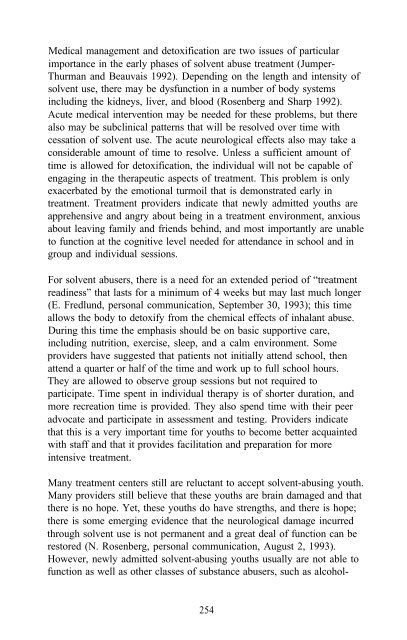Epidemiology of Inhalant Abuse - Archives - National Institute on ...
Epidemiology of Inhalant Abuse - Archives - National Institute on ...
Epidemiology of Inhalant Abuse - Archives - National Institute on ...
You also want an ePaper? Increase the reach of your titles
YUMPU automatically turns print PDFs into web optimized ePapers that Google loves.
Medical management and detoxificati<strong>on</strong> are two issues <str<strong>on</strong>g>of</str<strong>on</strong>g> particular<br />
importance in the early phases <str<strong>on</strong>g>of</str<strong>on</strong>g> solvent abuse treatment (Jumper-<br />
Thurman and Beauvais 1992). Depending <strong>on</strong> the length and intensity <str<strong>on</strong>g>of</str<strong>on</strong>g><br />
solvent use, there may be dysfuncti<strong>on</strong> in a number <str<strong>on</strong>g>of</str<strong>on</strong>g> body systems<br />
including the kidneys, liver, and blood (Rosenberg and Sharp 1992).<br />
Acute medical interventi<strong>on</strong> may be needed for these problems, but there<br />
also may be subclinical patterns that will be resolved over time with<br />
cessati<strong>on</strong> <str<strong>on</strong>g>of</str<strong>on</strong>g> solvent use. The acute neurological effects also may take a<br />
c<strong>on</strong>siderable amount <str<strong>on</strong>g>of</str<strong>on</strong>g> time to resolve. Unless a sufficient amount <str<strong>on</strong>g>of</str<strong>on</strong>g><br />
time is allowed for detoxificati<strong>on</strong>, the individual will not be capable <str<strong>on</strong>g>of</str<strong>on</strong>g><br />
engaging in the therapeutic aspects <str<strong>on</strong>g>of</str<strong>on</strong>g> treatment. This problem is <strong>on</strong>ly<br />
exacerbated by the emoti<strong>on</strong>al turmoil that is dem<strong>on</strong>strated early in<br />
treatment. Treatment providers indicate that newly admitted youths are<br />
apprehensive and angry about being in a treatment envir<strong>on</strong>ment, anxious<br />
about leaving family and friends behind, and most importantly are unable<br />
to functi<strong>on</strong> at the cognitive level needed for attendance in school and in<br />
group and individual sessi<strong>on</strong>s.<br />
For solvent abusers, there is a need for an extended period <str<strong>on</strong>g>of</str<strong>on</strong>g> “treatment<br />
readiness” that lasts for a minimum <str<strong>on</strong>g>of</str<strong>on</strong>g> 4 weeks but may last much l<strong>on</strong>ger<br />
(E. Fredlund, pers<strong>on</strong>al communicati<strong>on</strong>, September 30, 1993); this time<br />
allows the body to detoxify from the chemical effects <str<strong>on</strong>g>of</str<strong>on</strong>g> inhalant abuse.<br />
During this time the emphasis should be <strong>on</strong> basic supportive care,<br />
including nutriti<strong>on</strong>, exercise, sleep, and a calm envir<strong>on</strong>ment. Some<br />
providers have suggested that patients not initially attend school, then<br />
attend a quarter or half <str<strong>on</strong>g>of</str<strong>on</strong>g> the time and work up to full school hours.<br />
They are allowed to observe group sessi<strong>on</strong>s but not required to<br />
participate. Time spent in individual therapy is <str<strong>on</strong>g>of</str<strong>on</strong>g> shorter durati<strong>on</strong>, and<br />
more recreati<strong>on</strong> time is provided. They also spend time with their peer<br />
advocate and participate in assessment and testing. Providers indicate<br />
that this is a very important time for youths to become better acquainted<br />
with staff and that it provides facilitati<strong>on</strong> and preparati<strong>on</strong> for more<br />
intensive treatment.<br />
Many treatment centers still are reluctant to accept solvent-abusing youth.<br />
Many providers still believe that these youths are brain damaged and that<br />
there is no hope. Yet, these youths do have strengths, and there is hope;<br />
there is some emerging evidence that the neurological damage incurred<br />
through solvent use is not permanent and a great deal <str<strong>on</strong>g>of</str<strong>on</strong>g> functi<strong>on</strong> can be<br />
restored (N. Rosenberg, pers<strong>on</strong>al communicati<strong>on</strong>, August 2, 1993).<br />
However, newly admitted solvent-abusing youths usually are not able to<br />
functi<strong>on</strong> as well as other classes <str<strong>on</strong>g>of</str<strong>on</strong>g> substance abusers, such as alcohol-<br />
254
















